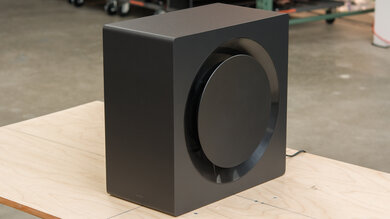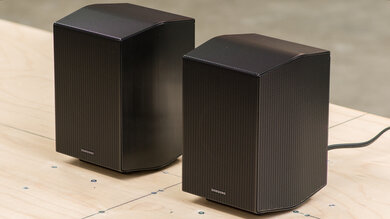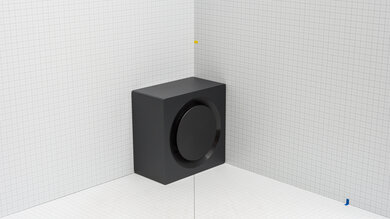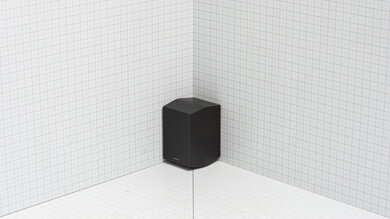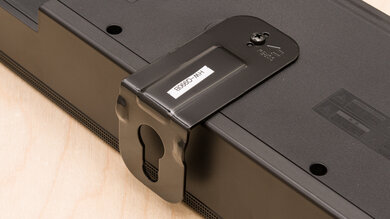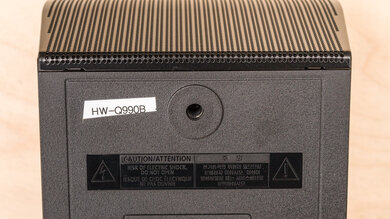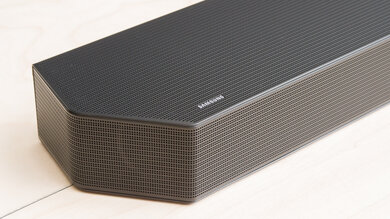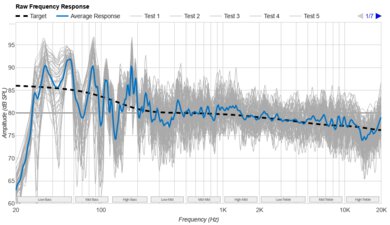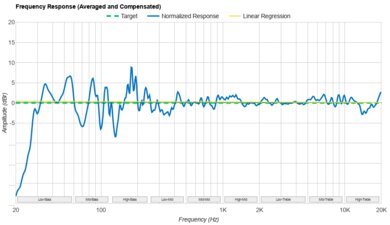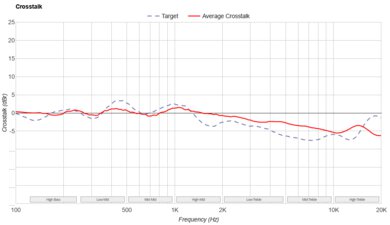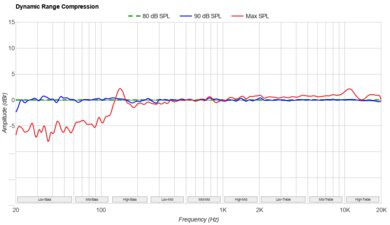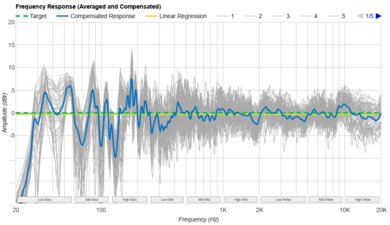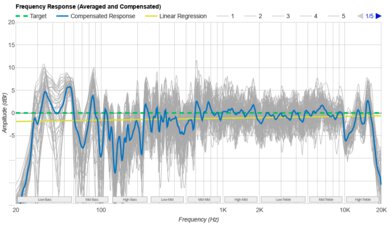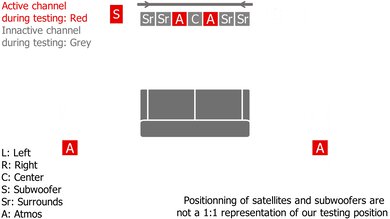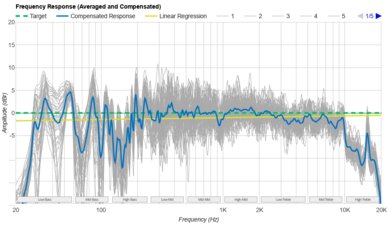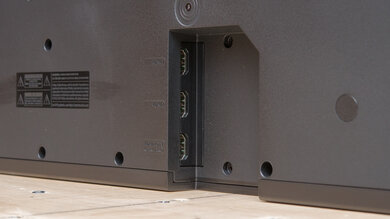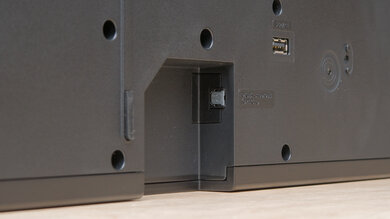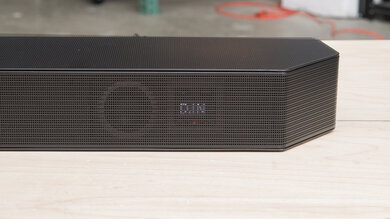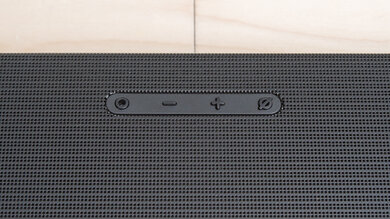The Vizio Elevate soundbar is a 5.1.4 setup with a unique design. When you watch Dolby Atmos or DTS:X content, the sides of the bar automatically rotate upwards, resulting in a wide and immersive-sounding soundstage. You can rotate the sides upwards when you listen to other types of audio content, too, or you can turn it off entirely. Right out of the box, the bar's sound profile is bass-heavy, and vocals and lead instruments are mostly clear but also quite bright due to the recessed treble. That said, you can use its bass and treble adjustments to customize its sound based on your preferences.
Our Verdict
The Vizio Elevate 5.1.4 is good for mixed usage. This versatile soundbar has a balanced mid-range that reproduces voices in podcasts and TV shows with clarity. There's some extra boom in the bass range that helps you feel the excitement in bass-heavy music and action-packed movies, which some users will want to tame by adjusting the bass level. Thanks to its discrete satellites, the action in your favorite movies seems to take place all around you, resulting in an immersive listening experience.
- Bluetooth, Wi-Fi, and Chromecast built-in compatibility.
- Four EQ presets.
- Wide, focused soundstage.
- No graphic EQ.
- Some compression at max volume.
The Vizio Elevate soundbar is good for vocal-centric content like TV shows. This 5.1.4 setup comes with a discrete center channel, so voices accurately anchor to pinpoint locations in the soundstage. With its balanced mids, voices reproduce clearly and there's even a treble adjustment feature and a dialogue enhancement mode to help make voices more clear and crisp in your audio.
- Dialogue enhancement feature.
- Bluetooth, Wi-Fi, and Chromecast built-in compatibility.
- Poor latency performance via eARC and HDMI In.
The Vizio Elevate 5.1.4 is decent for music. It can reproduce vocals and lead instruments pretty clearly out of the box, though higher frequencies sound a little harsh due to the prominent treble range. There's extra boom in the bass range that helps you feel the rumble in bass-heavy genres like EDM and hip-hop, too. If you prefer a more neutral sound, fortunately, bass and treble adjustments are also available. However, you won't find a graphic EQ to help you customize the bar throughout the range.
- Bluetooth, Wi-Fi, and Chromecast built-in compatibility.
- Four EQ presets.
- No graphic EQ.
- Some compression at max volume.
The Vizio Elevate soundbar is good for movies. Thanks to its rotating sides, it has a wide soundstage with good focus, making it seem like sound objects are coming from a pinpoint location. For example, cars in a chase scene seem to race past you from one side of the screen to another. It's a decent choice for surround sound, too, and it also supports Dolby Atmos content.
- Dialogue enhancement feature.
- Four EQ presets.
- Wide, focused soundstage.
- Some compression at max volume.
- Poor latency performance via eARC and HDMI In.
Changelog
-
Updated Mar 03, 2025:
We referenced the Vizio Elevate SE SL512X-0806 in the Audio Format Support: Optical box.
- Updated Aug 29, 2024: Updated the Stereo Dynamics results with new methodology from Test Bench 1.3. Added text to Audio Latency: ARC, Audio Latency: HDMI In, and Audio Latency: Optical boxes.
- Updated Aug 28, 2024: We've converted this review to Test Bench Update 1.3. If applicable, we've retested stereo sound based on the manufacturer's recommendations. Additionally, we've expanded our audio latency tests to the following boxes: Audio Latency: ARC, Audio Latency: HDMI In, and Audio Latency: Optical. You can see the full changelog here.
- Updated Jun 07, 2023: Converted to Test Bench 1.2. Updated the results for audio format support via ARC/eARC, HDMI In, and Optical. Added Video Passthrough to TV results as well.
Check Price
Differences Between Sizes And Variants
The Vizio Elevate soundbar comes in one color variant: Black. You can see the label for the model we tested here.
If you come across another variant, let us know in the comments.
Popular Soundbar Comparisons
The Vizio Elevate sound bar is a 5.1.4 setup with a unique design that allows you to rotate the left and right sides of the bar to create a wide, focused soundstage. It's a versatile soundbar that supports Dolby Atmos and DTS:X content. However, compared to other premium bars on the market, its default sound profile is a bit bass-heavy and can sound sharp in the treble range. There's no room correction feature, either.
If you want to see more soundbars, check out our recommendations for the best soundbars, the best Dolby Atmos soundbars, and the best 5.1 soundbars.
The Vizio Elevate is a better soundbar than the Sonos Arc. The Sonos has a bright sound profile that lacks a bit of bass, especially compared to the Vizio's bass-heavy sound profile. The Vizio has a Full HDMI In port that supports 4k passthrough, unlike the Sonos. You can check out the Sonos Arc with Sub + One SL Speakers to compare its performance with its full setup.
The Vizio Elevate SE SL512X-0806 is a more affordable entryway into Vizio's Elevate lineup of soundbars than the top-of-the-line Vizio Elevate. The cheaper sibling loses video passthrough to TV, WiFi playback, optical inputs, a full HDMI input port, and a remote. Whether you need those features is a question only you can answer. But if you don't, the cheaper Elevate SE SL512X-0806 is well worth considering as it performs very similarly to the more expensive flagship in terms of audio reproduction.
Depending on your listening habits, you may prefer either the Vizio Elevate or the Vizio M Series M512a-H6. The Elevate is better built and has a better Atmos performance. It supports more wireless playback options. The M Series has less compression at max volume, so your audio sounds cleaner during louder listening sessions.
JBL Bar 9.1 is a better soundbar than the Vizio Elevate. The JBL has a somewhat more balanced default sound profile, so it's suitable for a wider variety of audio content. It also offers better center channel and surround performance, though both bars have a similarly wide soundstage. It also has a room correction feature and is compatible with Apple AirPlay, unlike the Vizio. The Vizio comes with more sound enhancement options, like bass and treble adjustment and a dialogue enhancement mode.
Test Results





